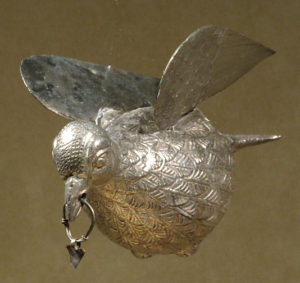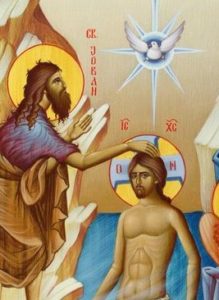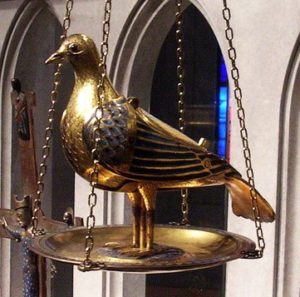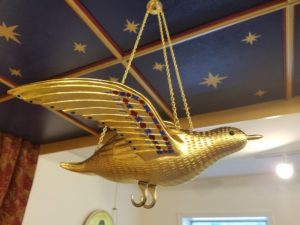Christ our God took bread and wine and said “This is my Body… This is my Blood.” From that time forward, the Church has understood these words, not in a metaphorical sense, but to express a deep and mysterious reality. The bread and wine which we offer become Christ’s Body and Blood as nourishment for our journey through life. God has chosen to share His life with us in many ways, but most clearly as medicine for our souls, and as food to strengthen and sustain us to live godly lives, for life in the Kingdom. As we accept and receive that great gift, the only appropriate response is to give God our thanks and praise, by our worship and by the way we live.
 The consecrated bread, or Host (from the Latin Hostia or Victim) is kept, or reserved, in the pyx and tabernacle, following the distribution of communion. The primary reason for this reservation is that the Sacrament may be taken to the sick, the shut-in, and those who are nearing death; Saints Justin Martyr, Cyprian, and Basil all speak of this practice from earliest times. Knowing that God is with us under the form of bread and wine, and that this Presence is housed in the tabernacle, has also led the faithful through the centuries, to pray before the tabernacle and the altar. Such prayer and adoration became more common in the West, in opposition to false teachings which arose during the Middle Ages, denying that the bread and wine of the Eucharist truly become the Body and Blood of Christ.
The consecrated bread, or Host (from the Latin Hostia or Victim) is kept, or reserved, in the pyx and tabernacle, following the distribution of communion. The primary reason for this reservation is that the Sacrament may be taken to the sick, the shut-in, and those who are nearing death; Saints Justin Martyr, Cyprian, and Basil all speak of this practice from earliest times. Knowing that God is with us under the form of bread and wine, and that this Presence is housed in the tabernacle, has also led the faithful through the centuries, to pray before the tabernacle and the altar. Such prayer and adoration became more common in the West, in opposition to false teachings which arose during the Middle Ages, denying that the bread and wine of the Eucharist truly become the Body and Blood of Christ.
Throughout both Scripture and the life of the Church, the image of a dove is used to indicate the presence of God. In Genesis, chapter one, we are told that God created by His Word and by His Spirit. The Holy Spirit moved or hovered over the face of the waters; the Talmud states that the Spirit hovered as a dove over her children. In the story of Noah, following the flood, a dove showed when it was safe to leave the ark, as a sign of God’s favor. When offering sacrifice for atonement, of all birds, only doves or young pigeons were said to be pure enough to offer to God (Lev. 1:14), and doves were the accepted offering by those too poor to offer a lamb (Lev. 12:8), as we find when Mary and Joseph presented the child Jesus in the Temple (Luke 2:24).
 The most notable appearance of the image of the dove in the New Testament is at the Baptism of our Lord. Matthew 3:16 tells us, “Jesus, when he was baptized, went up straightway out of the water: and, lo, the heavens were opened unto him, and he saw the Spirit of God descending like a dove, and lighting upon him.” Here the image of a dove is used to describe a Theophany, a showing of the presence of God. While the Acts of the Apostles states that the Holy Spirit descended as tongues of fire upon the Apostles (Acts 2:3), both Orthodox iconography and later Western art often use the image of the Holy Spirit descending as a dove upon the Church at Pentecost, and occasionally show the Holy Spirit descending upon the Blessed Virgin Mary at the Annunciation as a dove, in like manner.
The most notable appearance of the image of the dove in the New Testament is at the Baptism of our Lord. Matthew 3:16 tells us, “Jesus, when he was baptized, went up straightway out of the water: and, lo, the heavens were opened unto him, and he saw the Spirit of God descending like a dove, and lighting upon him.” Here the image of a dove is used to describe a Theophany, a showing of the presence of God. While the Acts of the Apostles states that the Holy Spirit descended as tongues of fire upon the Apostles (Acts 2:3), both Orthodox iconography and later Western art often use the image of the Holy Spirit descending as a dove upon the Church at Pentecost, and occasionally show the Holy Spirit descending upon the Blessed Virgin Mary at the Annunciation as a dove, in like manner.
 The symbol of the dove carrying an olive branch became a sign of enduring peace, and early Christians used this image in association with both baptism and burial. Many saints, including our own St. Gregory, are depicted in icons with doves, representing the Holy Spirit, speaking in their ears. The dove also became a symbol of the presence of God within the elements of the Eucharist, and containers to hold the Host (or consecrated bread) were often fashioned in the form of a dove, called peristerium or columba. In every Divine Liturgy, the celebrant prays that the Holy Spirit will descend upon the offerings, making the bread and wine become the Body and Blood of Christ, an action portrayed by the dove hovering over the altar. Tertullian spoke of the Church as the “columbae domus”, the house of the dove, leading some to say that dove-shaped Eucharistic vessels may have been in use by the third century. In the life of St. Basil the Great (d. 379) we read that the saint “commissioned a goldsmith to fashion a dove of pure gold, as an image of what took place at the Baptism of Christ, when John the Baptist bore witness, saying, ‘I have beheld the Spirit descending out of heaven as a dove, and He abode upon Him’. He then suspended it above the holy table as a receptacle in which to store the Mysteries.” A hanging dove, made of silver in Syria and dating from the sixth or seventh century is now in the collection of the Metropolitan Museum of Art in New York. During the Middle Ages many such Eucharistic doves were made of precious metals, with enamel decoration, notably in the city of Limoges in France, one of which may now be seen at the Walters Art Museum in Baltimore.
The symbol of the dove carrying an olive branch became a sign of enduring peace, and early Christians used this image in association with both baptism and burial. Many saints, including our own St. Gregory, are depicted in icons with doves, representing the Holy Spirit, speaking in their ears. The dove also became a symbol of the presence of God within the elements of the Eucharist, and containers to hold the Host (or consecrated bread) were often fashioned in the form of a dove, called peristerium or columba. In every Divine Liturgy, the celebrant prays that the Holy Spirit will descend upon the offerings, making the bread and wine become the Body and Blood of Christ, an action portrayed by the dove hovering over the altar. Tertullian spoke of the Church as the “columbae domus”, the house of the dove, leading some to say that dove-shaped Eucharistic vessels may have been in use by the third century. In the life of St. Basil the Great (d. 379) we read that the saint “commissioned a goldsmith to fashion a dove of pure gold, as an image of what took place at the Baptism of Christ, when John the Baptist bore witness, saying, ‘I have beheld the Spirit descending out of heaven as a dove, and He abode upon Him’. He then suspended it above the holy table as a receptacle in which to store the Mysteries.” A hanging dove, made of silver in Syria and dating from the sixth or seventh century is now in the collection of the Metropolitan Museum of Art in New York. During the Middle Ages many such Eucharistic doves were made of precious metals, with enamel decoration, notably in the city of Limoges in France, one of which may now be seen at the Walters Art Museum in Baltimore.
The word Pyx is commonly used in the West to speak of the actual box which holds the reserved Sacrament, and it was a common practice to place the Pyx within the back of the dove. The Custumal of the great French monastery of Cluny in the eleventh century speaks of the “deacon taking the golden pyx out of the dove (columba) which hangs permanently above the altar”. While many churches reserved the Sacrament in a “hanging Pyx” in the form of a dove, others had ornate boxes covered with veils suspended above the altar. The lives of St. Sylvester and St. Innocent (fourth and fifth centuries) however, both make mention of towers of precious metal to house Eucharistic doves, rather than suspending the doves above the altar, a practice which may have led to the later development of the tabernacle to house the reserved Sacrament, which eventually became the more common practice, both in the East and in the West.
 At St. Gregory’s we previously reserved the Sacrament in a Pyx placed inside a small tabernacle made in Greece (actually intended to house the consecrated Host, or Lamb, for the pre-Sanctified Liturgy). A generous donor commissioned a Eucharistic dove for St. Gregory’s and it was blessed during the visitation of His Grace, Bishop JOHN in 2019. Our dove has been carved of English Basswood, covered with gold-leaf, and decorated with enamel accents by Massachusetts marine artist and wood-carver, Paul Garnett. It is suspended above the altar where our sanctuary lamp had been, and a new sanctuary lamp has been hung on the wall nearby (a candle burns in this lamp, indicating the presence of the reserved Sacrament).
At St. Gregory’s we previously reserved the Sacrament in a Pyx placed inside a small tabernacle made in Greece (actually intended to house the consecrated Host, or Lamb, for the pre-Sanctified Liturgy). A generous donor commissioned a Eucharistic dove for St. Gregory’s and it was blessed during the visitation of His Grace, Bishop JOHN in 2019. Our dove has been carved of English Basswood, covered with gold-leaf, and decorated with enamel accents by Massachusetts marine artist and wood-carver, Paul Garnett. It is suspended above the altar where our sanctuary lamp had been, and a new sanctuary lamp has been hung on the wall nearby (a candle burns in this lamp, indicating the presence of the reserved Sacrament).
Our new Eucharistic Dove serves as a continual reminder of the Presence of God in our midst, of the favor of God for His people, and of the Holy Spirit working to feed, strengthen, guide and sanctify the people of God, that we may share the Good News of Christ, and serve in His Name.